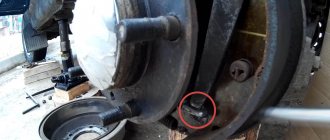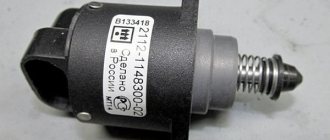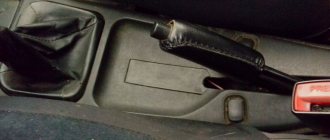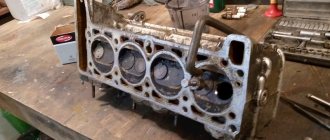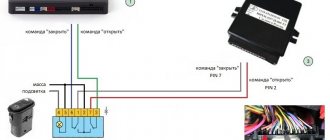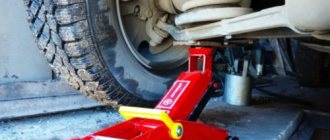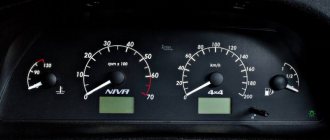Published:
12.03.2017
As on any other car, the Chevrolet Niva parking brake is an integral part of the braking system. Its purpose is to prevent spontaneous movement of the vehicle during parking or temporary parking with the engine running. But the handbrake can also replace the main brake system in the event of its failure, which allows you to safely get to the repair site. You have to use the handbrake quite often, so its cable and brake pads are subject to intense wear. As a result, car owners over time have to take measures to adjust the system or replace its individual parts. While some people turn to a car repair shop for this, others prefer to carry out repair work themselves. If you belong to the second category of car enthusiasts and would like to know how to tighten or replace the handbrake on a Chevrolet Niva, then the material in this article will be useful for you.
The design of the Chevrolet Niva parking brake differs little from similar systems in other passenger cars
The design of the parking brake of a Chevrolet Niva is quite simple and is not much different from similar systems in other passenger vehicles. It consists of the following main parts:
- Handbrake lever - serves to transmit the force of the human hand to the actuator, which, in turn, acts on the brake pads to lock the rear wheels.
- The handbrake cable is a carbide, specially manufactured steel wire that runs under the bottom of the vehicle and operates the brake pads on the rear wheels.
- Brake pads are the final elements of the brake system, made of friction materials. By pressing against the brake drum or disc, they immobilize the wheel.
The manual braking system also includes such functional elements as a spacer sleeve, a brake pad drive lever, a spring, a protective sheath for the rear cable, a cover for the front handbrake cable, and a ratchet mechanism for the lever.
The handbrake system contains many structural elements
How to replace the handbrake cable
Sometimes adjusting the handbrake does not bring the desired result due to the fact that the rear cable is overstretched. In this case, the only way out of the situation is to replace the Chevrolet Niva hand brake cable. In addition, the cable will have to be replaced if it regularly jams in the protective sheath or breaks due to wear.
- To carry out the replacement, the rear of the vehicle must be in a hanging position. Therefore, lift it using a lift or jack and remove the brake drums from the rear wheels.
- Using a “12” wrench, loosen the locknut on the adjusting rod and completely unscrew it together with the adjusting nut. You must first remove the spring from the rod, as it will not allow you to unscrew the nuts.
- After this, you can easily remove the cable equalizer and remove the cable itself from it.
- Next, by pulling the cable towards you, remove the ends of the shell from the brackets located on the left and right on the bottom of the body.
- Using manual force, remove the right and left branches of the cable from the rear axle beam brackets.
- Using a wrench, unscrew the bolts securing the holders to the brake flaps.
- Now, having disconnected the cable ends from the brake pad drive levers, pull it to remove it from the hole in the brake shield.
After dismantling, install a new Niva rear hand brake cable. To do this, also use these instructions, but perform all the steps in reverse order. And with this, the replacement of the Chevrolet Niva handbrake cable is completed, and finally, do not forget to adjust the degree of its tension. It is also important to lubricate the adjusting threads on the rod upon completion of the repair work to avoid problems with unscrewing the nuts during the next adjustment or replacement.
As on any other car, the Chevrolet Niva parking brake is an integral part of the braking system. Its purpose is to prevent spontaneous movement of the vehicle during parking or temporary parking with the engine running. But the handbrake can also replace the main brake system in the event of its failure, which allows you to safely get to the repair site.
You have to use the handbrake quite often, so its cable and brake pads are subject to intense wear. As a result, car owners over time have to take measures to adjust the system or replace its individual parts. While some people turn to a car repair shop for this, others prefer to carry out repair work themselves.
The design of the Chevrolet Niva parking brake differs little from similar systems in other passenger cars
The design of the parking brake of a Chevrolet Niva is quite simple and is not much different from similar systems in other passenger vehicles. It consists of the following main parts:
- Handbrake lever - serves to transmit the force of the human hand to the actuator, which, in turn, acts on the brake pads to lock the rear wheels.
- The handbrake cable is a carbide, specially manufactured steel wire that runs under the bottom of the vehicle and operates the brake pads on the rear wheels.
- Brake pads are the final elements of the brake system, made of friction materials. By pressing against the brake drum or disc, they immobilize the wheel.
The manual braking system also includes such functional elements as a spacer sleeve, a brake pad drive lever, a spring, a protective sheath for the rear cable, a cover for the front handbrake cable, and a ratchet mechanism for the lever.
The handbrake system contains many structural elements
Why do you need a handbrake on a Chevrolet Niva?
The parking brake is necessary to reliably hold the car in place during a short stop or long-term parking, which is especially important on uneven ground or roads. For inexperienced drivers, the handbrake will become an indispensable assistant when starting uphill; it helps not to roll back, but to immediately start moving forward.
If you need to leave the car for a short time, but don’t want to turn it off (for example, in the morning, when warming up), then using the parking brake is mandatory so that the started car does not roll (an unstarted car can stand “at speed”).
also prohibited to leave a car on a slope without a parking brake , in order to avoid creating an emergency situation. The parking brake must be in working order, adjusted and keep the vehicle on the slope, according to the recommendations described in the Operator's Manual.
Another extremely important property is that it will help stop the car if the main brake system fails . In the event of a failure of the main brake system (usually hydraulic or pneumatic), it is necessary to smoothly tighten the cable of the mechanical handbrake by pulling its lever up, the main thing is not to overtighten and not let the car skid. With a mechanical handbrake this is not difficult, but with modern electronic ones it is impossible. Fortunately, the Chevrolet Niva has a mechanical parking brake and its setting and adjustment is done manually.
How to check and adjust the tension of the handbrake cable
If the parking brake is able to hold the car stationary on a 25% slope, then it is doing its job as expected. If you pull the handbrake lever seven ratchet clicks or more, but the car still rolls, the conclusion is the following: the handbrake system is not working effectively.
In such a situation, adjustment of the Chevrolet Niva hand brake is required. This type of repair is simple, performed relatively quickly and does not require the use of special equipment. All you need for work are two keys “12”, pliers and a jack if it is not possible to put the car on the inspection hole.
To work, you need to put the Chevrolet Niva on the inspection hole
- First, check whether the handbrake really does not hold the car on the road at a slope of 25%. To do this, place the vehicle on an overpass or find a suitable section of road. If the problem occurs, then we proceed to adjustment.
- Setting the optimal parking brake cable tension is done under the car, so it is better to place it above the inspection hole. If this is not possible, use a lift or jack. In any case, the rear of the car must be raised.
- When the vehicle is ready for use, secure it and release the handbrake lever.
- Next, using a wrench, loosen the lock nut on the handbrake adjusting rod, then use a second identical wrench to tighten the adjusting nut until the cable is properly tensioned. By the way, pliers are needed to keep the rod from turning during the adjustment process.
- Now tighten the locknut and make a full stroke first to the working position, and then lower it. After this, spin each rear wheel by hand. The rotation must be uniform, jerking is not allowed. If any are felt, adjusting the Chevrolet Niva handbrake requires repeating.
And also interesting: How to reduce the fuel consumption of a Niva
And the last stage is a test of the handbrake in road conditions. That is, you need to carry out a standard check of the parking brake's effectiveness, as described in the first paragraph of the manual.
After assembly, the handbrake must be tested in road conditions.
Parking brake system (hand brake): device and adjustment
Adjusting the hand brake
We install the car on an inspection ditch or a lift.
We hang the rear axle of the car and lower the parking brake lever to the lower position.
Lubricate the threads of the cable end with WD type lubricant.
Holding the adjusting nut with a 13mm wrench, use the same wrench to loosen the locknut. |
Holding the end of the cable with pliers, use a 13 key to tighten the adjusting nut (while achieving the required number of clicks for the full stroke of the lever in the cabin) |
You can also hold the tip of the cable at the point where it connects with the spring by clamping its end with pliers.
In this case, the full stroke of the parking brake drive lever should be 4–5 teeth of the ratchet sector. When the lever is fully lowered, the wheels should rotate freely without binding. In this position, tighten the locknut.
Parking brake adjustment unit:
1 – front parking brake cable; 2 – adjusting nut; 3 – lock nut; 4 – rear parking brake cable; 5 – piece of tube
Increased parking brake adjustability
If a spare thread is used on the tip of the front parking brake cable (as shown in Fig. a), you can select a piece of a suitable tube (Fig. b) and put it on the tip under the adjusting nut. Now the possibility of adjustment will increase.
Washer for securing the parking brake cable
If the parking brake stops holding, the cause may be loose legs of the bracket holding the rear cable sheath. In this case, to fix the cable sheath in the bracket, you can use a washer with a slot, which should be inserted between the bracket and the sheath bushing. The slot of the washer should be directed “against” the slot in the bracket.
Cable attachment: 1 – bushing; 2 – shell; 3 – bracket; 4 – additional washer |
Video
Source
Replacing a short handbrake cable on a Chevrolet Niva
As I wrote earlier, slowly but surely, my handbrake cable was getting damaged, and the cable jacket was calloused. Finally, it got warmer outside from -25 to -3, and it was stupid to miss the last days of vacation.
I didn’t think that you might not find spare parts in stock for a Russian-made car, but ShNG is a different story. I drove around all the shops in the city, and everywhere I say that I have one cable like on 2106 or 2121, they stare at me and either snub 2 cables, or try to sell me from 21 Niva.
A week ago, I poured motor oil into the cable jacket and hung it so that it spread along the entire length. On the third day, it started dripping from the second end of the shirts, which means everything was lubricated as it should. Now the cable will not freeze if water gets inside, and it will not rot either. I also cut the springs on the cables, an old technique worked on the nine and six, why not do it on the field.
When replacing everything is standard, we hang up the axle, take off the wheels, take off the drums, but here’s the problem. The old owner left a gift, where there should be a threaded hole for removing the drum, a piece of a bolt sticks out, and it was not possible to tighten it with one bolt until I heated it with a gas burner. Upon further inspection of the drum, I find a second jamb.
The cable served 120 thousand kilometers in 2 years 8 months, which is not bad in principle) For the last 2 weeks I drove without a handbrake - it’s somehow unusual, so today I replaced the old tired cable. Since the BBC did not have a cable for the shniva in stock at that time, I bought it The officials sold it for 400 rubles; in the store it would have been 70 rubles cheaper. Special thanks to Ivanokk, who kept up the conversation in the garage and poured fresh kvass into the mug)
First, remove the spring and unscrew the locknut and nut that tension the cable. Remove the washer and guide plate. If the tension nut does not unscrew, but turns together with the front cable, use WD 40 to help and hold the front cable with pliers.
We counter, install the spring, rejoice at the working handbrake))
The mechanically actuated parking brake system acts on the brake mechanisms of the rear wheels.
The parking brake is mechanically driven from lever 1 (Fig. 1).
The middle part of the rear cable passes through the groove of guide 7, the tension of which is adjusted with a nut screwed onto the threaded end of the front cable.
A spacer sleeve 8 is installed between the guide 7 and the adjusting nut.
Rice. 1. Parking brake drive parts
At the rear ends of the cable there are tips, each of which is connected to the hook of the lever 11 for the manual drive of the shoes.
This lever is pivotally attached to the brake shoe with a finger and its upper part rests against the groove of the spacer bar 10.
The rib of the brake pad is installed in the opposite groove of the bar.
We repair Niva VAZ-21213; 21214: Illustrated Guide
This section presents auto parts for products of the Volzhsky Automobile Plant (VAZ), the largest manufacturer of passenger cars in Russia. If you need to replace a failed device or component of your Lada or Niva, you have come to exactly the right place; all the necessary spare parts for the VAZ are presented here.
The section contains more than 25,000 items of goods. Thanks to a convenient search and electronic catalog, you can easily find parts for any line of cars from the leader of the domestic automobile industry: we have spare parts for both new VAZ models (Granta, Kalina, Priora, Largus), and for rear- and front-wheel drive long-known to Russian motorists (Samara , OKA, “classic”, etc.), as well as all-wheel drive VAZs (Niva, Chevrolet Niva). You will find gearboxes, cylinder blocks, engines, clutches from various manufacturers, pistons, shock absorbers, oil seals, steering rods, clutch actuators and much more for your car here.
We cooperate with leading manufacturers of VAZ spare parts, suppliers of the Tolyatti Automobile Plant conveyor. Each product meets all necessary quality standards.
Sources
- https://examiner.edocar.ru/skachat-rukovodstvo-po-ekspluatatsii-niva-21213.html
- https://www.avtoall.ru/vaz/search/Brake light switch/
Replacing the rear parking brake cable
Replace the rear cable if it is excessively stretched (impossibility of adjusting the parking brake), mechanical damage and loss of mobility in the sheath.
You will need: keys “8”, “13” (two), cobra pliers, pliers.
Also interesting: Bleeding Chevrolet Niva brakes: step-by-step instructions
Loosen the locknut on the front cable end.
While holding the tip from turning with pliers, unscrew the lock nut and the adjusting nut to the end of the tip.
While holding the tip from turning, remove the lock nut, adjusting nut and spacer from the tip
Remove the guide from the tip and disconnect it from the cable
Remove the cable from the rear axle beam bracket and.
. from the body bracket hole.
Remove the two bolts securing the cable sheath holder to the brake shield.
Disconnect the end of the parking brake cable from the drive lever
Pull the cable out of the hole in the brake shield
Similarly, remove the right branch of the cable and remove the rear cable from the car.
Install the new cable on the vehicle in the reverse order of removal.
Replacing parking brake cables
All models under consideration are equipped with an airbag. The airbag is constantly in an “alert” state and can operate (inflate) at any time when the battery is connected. To prevent accidental airbag deployment (and resulting injury), turn the ignition key to the LOCK position and disconnect the negative cable from the battery whenever performing any work on any safety system components.
| Replace the rear parking brake cable if it is excessively stretched (impossibility of adjusting the parking brake), or if there is mechanical damage to the cable strands or its sheath. Each brake mechanism of the rear wheels is driven by a separate cable. Removal and installation of the left cable are shown. The right cable is removed and installed in the same way.
1. Loosen the tension of the drive cables by unscrewing the adjusting nut to the very end of the threaded end of the front cable (see paragraphs 1 and 2 “Replacing the front parking brake cable”), but without removing the nut completely. 2. Disconnect the end of the rear drive cable from the equalizer by moving it out of the equalizer slot. 3. After unscrewing the fastening nuts, remove the cable support bracket on the fuel tank shield... 4. ...then the front one... 5. ...and rear holders on the body... 6. ...as well as a holder on the rear suspension arm. 7. Using a screwdriver, remove the installation sleeve of the cable sheath from the bracket on the base of the body... 8. ...and remove the cable from the bracket hole. 9. Remove the brake drum (see “Removing and installing the brake drum”). 10. Use a screwdriver to press the release lever forward... 11. ...and use pliers to disconnect the cable tip from the release lever. 12. On the back side of the brake shield, remove the spring clamp of the cable sheath... 13. ...and, pulling the cable through the hole in the shield, remove it from the car. 14. Install the rear parking brake cable in the reverse order of removal. 15. Adjust the parking brake system (see “Adjusting the parking brake drive”). Rice. 8.9. Parts of the parking brake drive: 1 – lever; 2 – button; 3 – thrust spring; 4 – latch rod; 5 – cover; 6 – front cable; 7 – rear cable guide; 8 – spacer sleeve; 9 – tension spring; 10 – spacer bar; 11 – lever for manual drive of the pads; 12 – rear cable The parking brake is mechanically driven from lever 1 (Fig. 8.9). The middle part of the rear cable passes through the groove of guide 7, the tension of which is adjusted with a nut screwed onto the threaded end of the front cable. A spacer sleeve 8 is installed between the guide 7 and the adjusting nut. At the rear ends of the cable there are tips, each of which is connected to the hook of the lever 11 for the manual drive of the shoes. This lever is pivotally attached to the brake shoe with a finger and its upper part rests against the groove of the spacer bar 10. The rib of the brake shoe is installed in the opposite groove of the bar. 1. Remove the brake drum (see “Removing and installing the brake drum”). Also interesting: Fuel consumption is a pressing problem for Chevrolet Niva drivers 2. Loosen the locknut on the front cable end. 3. While holding the tip from turning with pliers, unscrew the locknut and adjusting nut to the end of the tip. 4. Remove the spring. 5. While holding the tip from turning, remove the lock nut, adjusting nut, and spacer from the tip. 6. Remove the guide from the end and disconnect it from the cable. 7. Remove the cable from the rear axle beam bracket and. 8. . from the body bracket hole. 9. Remove the two bolts securing the cable sheath holder to the brake shield. 10. Disconnect the end of the parking brake cable from the drive lever. 11. Pull the cable out of the hole in the brake shield. 12. Similarly, remove the right branch of the cable and remove the rear cable from the car. 13. Install the new cable on the vehicle in the reverse order of removal. 14. Adjust the parking brake system (see “Checking and adjusting the parking brake”). Replacing the parking brake lever and front cable Replace the lever assembly if the gear sector or pawl is worn or damaged. Replace the front cable if it is excessively stretched (impossibility of adjusting the parking brake) or has mechanical damage.
1. Disconnect the rear cable with guide from the end of the front cable (see “Replacing the rear parking brake cable”). 2. Remove the floor tunnel lining (see “Removing and installing the floor tunnel lining”). 3. Remove the two bolts securing the lever bracket to the floor and remove the lever. 4. Remove the lever axle retaining ring. 5. Remove the lever shaft. 6. Pull the cable inside the cabin. 7. Install the new cable and lever in the reverse order of removal. 8. Adjust the parking brake system (see “Checking and adjusting the parking brake”). Now the cable will not freeze if water gets inside, or even rot. I also cut the springs on the cables, an old technique worked on the nine and six, why not do it on the field. Full size Pull the cable out of the groove in the holder. Next, remove the wheel, unscrew the screw with a 12mm wrench; on old cars there are two screws on the drum and remove the drum. I did this in less than a minute, because when I changed the rear pads at thousands of miles, I lubricated the adjacent plane of the hub with lithol. https://www.youtube.com/watch?v=ZDgQo2otkpk I decided to write down interesting points. If you have any questions, write in the comments - post Replacement of rear brake pads NIVA sp. We change the Niva brake pads ourselves http: How to change the handbrake lever on a Chevrolet Niva rear brake pads.
|
Chevrolet Niva RAMMSTEIN › Logbook › Replacing the front parking brake cable
The year before last, before a trip to Crimea, I changed the rear handbrake cable on the shnivy, I installed it from an AT company (Czech Republic). After installation, a week later, the handbrake stopped holding, and I drove without a parking brake for almost 2 years. And here we recently cleared the snow in front of the house so that the car is parked on a slope and constantly rolls towards the gate. And so that it wouldn’t roll, I decided to fix the handbrake after all.
